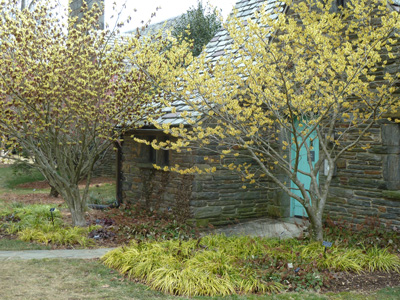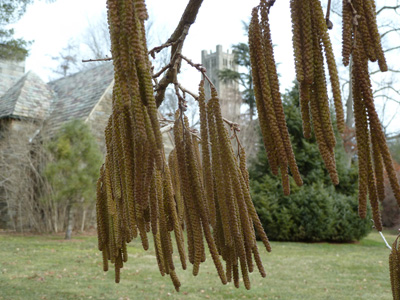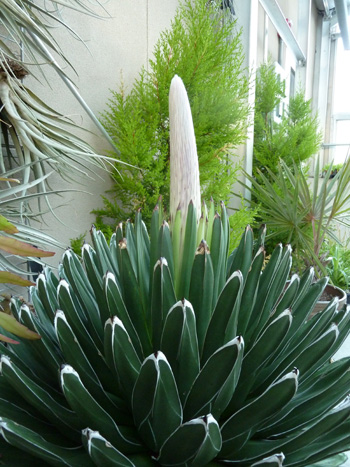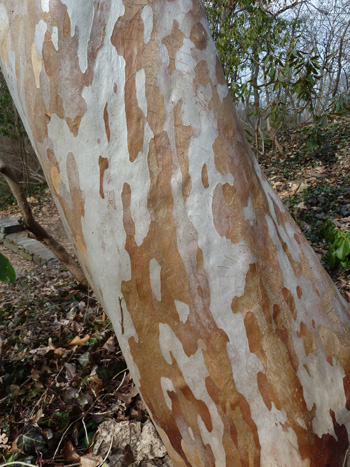Plants of the Week – February 18
 Interested in adding a witchazel to your garden but overwhelmed by the number of cultivar choices available? Rare Find Nursery alone offers over 30 cultivars in their print catalog! While there are numerous yellows, oranges, and reds to choose from, not all are created equal. One factor to consider is the tendency of Hamamelis to drop their leaves in the fall. Some cultivars drop all leaves allowing for a vivid, unobstructed floral display while others hold onto most of the foliage. Here two yellow-flowering Hamamelis x intermedia cultiars bloom side by side. H. x intermedia ‘Sunburst’ seen on the left, retains desiccated leaves while ‘Primavera’ flowers free from brown foliage. February is an ideal time to visit the arboretum’s collection of Hamamelis to experience the sight and spell of these winter beauties firsthand. Photo credit: J. Coceano
Interested in adding a witchazel to your garden but overwhelmed by the number of cultivar choices available? Rare Find Nursery alone offers over 30 cultivars in their print catalog! While there are numerous yellows, oranges, and reds to choose from, not all are created equal. One factor to consider is the tendency of Hamamelis to drop their leaves in the fall. Some cultivars drop all leaves allowing for a vivid, unobstructed floral display while others hold onto most of the foliage. Here two yellow-flowering Hamamelis x intermedia cultiars bloom side by side. H. x intermedia ‘Sunburst’ seen on the left, retains desiccated leaves while ‘Primavera’ flowers free from brown foliage. February is an ideal time to visit the arboretum’s collection of Hamamelis to experience the sight and spell of these winter beauties firsthand. Photo credit: J. Coceano
 February winds send the male catkins of Corylus colurna in expressive motion. The faintest of breezes creates movement among the pendulous flowers causing the entire tree to appear to shift and sway. The Turkish filbert ranges from Southeastern Europe to Western Asia and is hardy in zones 4 – 7. The deciduous tree, not often seen in North American landscapes, possesses great potential for increased use. Plants develop a beautiful rounded to pyramidal shape, display excellent drought tolerance once established, and bear edible fruit. Photo credit: J. Coceano
February winds send the male catkins of Corylus colurna in expressive motion. The faintest of breezes creates movement among the pendulous flowers causing the entire tree to appear to shift and sway. The Turkish filbert ranges from Southeastern Europe to Western Asia and is hardy in zones 4 – 7. The deciduous tree, not often seen in North American landscapes, possesses great potential for increased use. Plants develop a beautiful rounded to pyramidal shape, display excellent drought tolerance once established, and bear edible fruit. Photo credit: J. Coceano
 A beautiful specimen of Agave victoria-reginae was recently gifted to the arboretum. The slow growing plant, Agave victoria-reginae is grown in part for the beautiful streaks of white on the leaves. I envisioned this plant on display outdoors for many seasons to come. The agave had other plans. In the span of a few days a flower spike began to emerge! Plants flower after 20 – 30 years of vegetative growth. The act of flowering, so consuming of resources, exhausts the plant resulting in death. Photo credit: J. Coceano
A beautiful specimen of Agave victoria-reginae was recently gifted to the arboretum. The slow growing plant, Agave victoria-reginae is grown in part for the beautiful streaks of white on the leaves. I envisioned this plant on display outdoors for many seasons to come. The agave had other plans. In the span of a few days a flower spike began to emerge! Plants flower after 20 – 30 years of vegetative growth. The act of flowering, so consuming of resources, exhausts the plant resulting in death. Photo credit: J. Coceano
 The Japanese stewartia, Stewartia pseudocamellia, truly possesses year-round interest. Mature trees bear mottled bark in shades of brown, gray, and tan. Cup-shaped camellia-like flowers appear in early summer. Dark green foliage changes to shades of red-orange and burgundy as daylight shortens in autumn. This specimen is thriving as an understory tree beneath the towering Liriodendron tulipifera in the Scott Outdoor Amphitheater. Photo credit: J. Coceano
The Japanese stewartia, Stewartia pseudocamellia, truly possesses year-round interest. Mature trees bear mottled bark in shades of brown, gray, and tan. Cup-shaped camellia-like flowers appear in early summer. Dark green foliage changes to shades of red-orange and burgundy as daylight shortens in autumn. This specimen is thriving as an understory tree beneath the towering Liriodendron tulipifera in the Scott Outdoor Amphitheater. Photo credit: J. Coceano





Jan Semler
Posted at 13:53h, 21 FebruaryHi Josh. I always enjoy these posts. May I make a suggestion? Please include the location on campus of the plants highlighted. thanks.
Josh Coceano
Posted at 14:04h, 21 FebruaryHello Jan. Thanks for the comments. I’ll make a habit of adding a line after each plant description naming the location on campus.